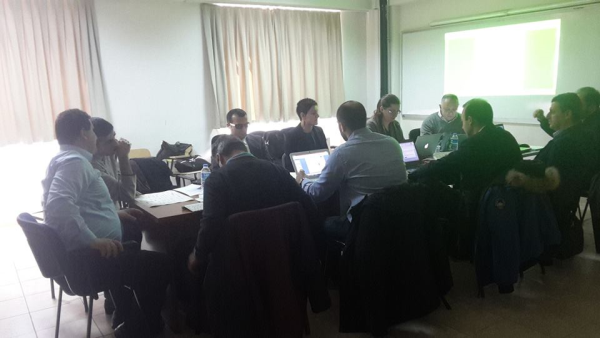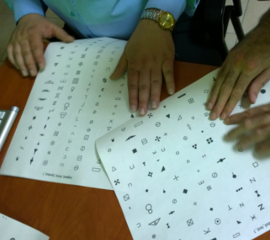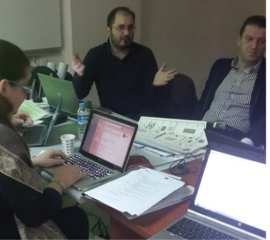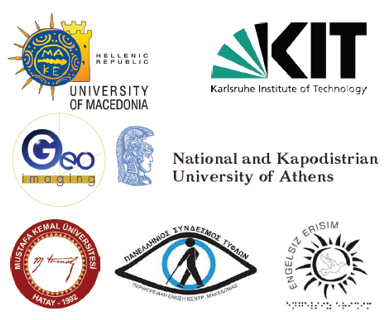2nd Issue, May 2015

ATMAPS - Specification of symbols used on audio-tactile maps for individuals with blindness
Newsletter No. 2
ATMAPS marks the end of its first year
Welcome to the second Newsletter of the ATMAPS project. In this newsletter, we want to inform you about the progress in project "Specification of symbols used on audio-tactile maps for individuals with blindness (ATMAPS)". It has been a year now that the project has been going on. In this issue, we will provide information about what we have accomplished in the second six months of the project.
2nd Progress Meeting held in Istanbul, Turkey at the Bosporus University premises Hosted by MKU and ABFA
Representatives from all seven partner organizations attended the second progress meeting of the project marking the end of the first year.

Highlights of our first Study
Our first study provides the basis for our future audio-tactile maps.
Creation of the survey
8 types of maps were determined; for indoor buildings, residential areas, campuses, city centres, political, physical, historic, and thematic maps. Word lists were generated for each map type by the lead partner and made available to all partners to add more possible words that would signify the symbols to be used on the audio-tactile maps. By the end of this process, 136 items for indoor buildings map, 226 items for the residential areas map, 213 items for the campus map, 222 items for city centres, 48 items for political, 82 items for physical, 85 items for historic, and 134 items for thematic map were considered to be the enriched final lists. Then, the words in each list were translated into Greek, German, and Turkish in addition to the original common language English. Finally, the lists accompanied with instruction for application were sent to each partner.
Data collection
Each partner, reached out to as many blind people to conduct the study with them. Each participant was informed about the study in general and then the procedure is explained. The participants were asked to evaluate each item included in the word lists for "How useful and significant is the information in regard to safety, location of services, way finding and orientation during movement? How frequently do they meet that information?" And finally, the format they prefer the information to be presented to them (audio, tactile, or audio-tactile). 120 blind individuals from four different countries were willing to participate in the study answering these questions. The interesting thing about this study is that we performed it in four languages which needs a close collaboration between the project partners and gives an insight in country-specific information. Our participants mentioned 1146 items which were collected dependent from the type of map: for indoor buildings, residential areas, campuses, city centres and political, physical historic and thematic maps.
Results
Such a study has not happened before with so many participants and in this extent. Participants from 5 different countries and many different cultures have participated. Some were familiar with technology and some were not as familiar. As the first step, we have conducted some descriptive analysis. Next, we will analyze the demographic data.
What is Next
The next step of our study is designing the tactile symbols. This topic was also covered in the 2nd progress meeting in Istanbul. Sample symbols were printed on capsule paper and brought to the meeting in order to be shown to all partners and to create the opportunity for all to experience how the testing of the symbols in the next phase of the study will be conducted.

|

|
Based on the analysis of the initial data, the research group realized that there was too many information, duplicated info, so the next step they followed was to reduce the information so it could be handled effectively by the visually impaired individuals. Therefore, as the WP2's 3rd and 4th tasks, the symbols were created. The symbols are to be tested in two ways in the next phase of our research: 1. As stand alone, only symbols and 2. As the symbols included in a map and based on the type of the maps (8 respective types of maps). Therefore we reduced the types of maps to be tested to 3 different maps (fictional indoors, residential and thematic/geographic). We have created the tests and included all the selected symbols.
Tests with 173 point symbols, 60 linear symbols, in 4 different random tests for each category of symbols is created. Each participant will be tested in one test (areal, linear, point). The test and the legends will be provided to each participant and then the participant will be asked to identify a symbol from the legend trying to find the same symbol on the symbols sheet. Therefore, we will be able to identify which symbols are the most recognizable by participants.
Up Next...
The 3rd progress meeting of the project will be held at the University of Athens in Athens, Greece end of may 2015. This meeting will also be joined by the external evaluator in order to review the progress of each task at hand. All partners are expected to attend the meeting.
Contact
Prof. Konstantinos Papadopoulos
University of Macedonia
Research Committee
156, Egnatia str
GR-54006
Website: www.atmaps.eu
Email: info@atmaps.eu
ATMAPS Consortium
|
 |
 This project (543316-LLP-1-2013-1-GR-KA3-KA3MP) has been funded with support from the European Commission. This publication [communication] reflects the views only of the author, and the Commission cannot be held responsible for any use which may be made of the information contained therein.
This project (543316-LLP-1-2013-1-GR-KA3-KA3MP) has been funded with support from the European Commission. This publication [communication] reflects the views only of the author, and the Commission cannot be held responsible for any use which may be made of the information contained therein.